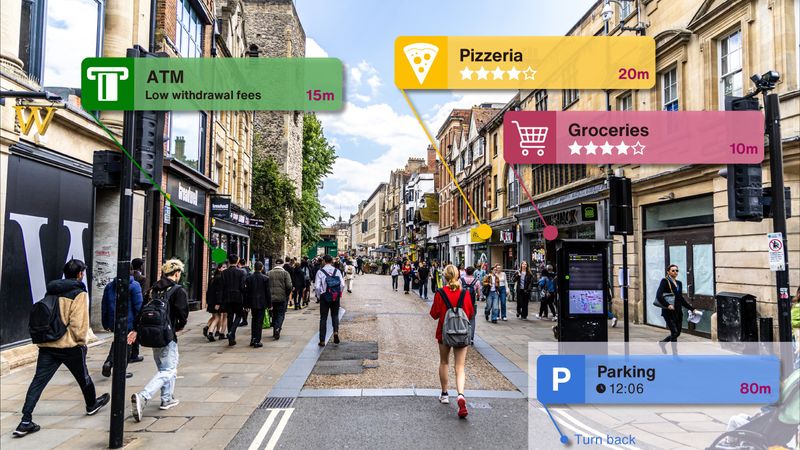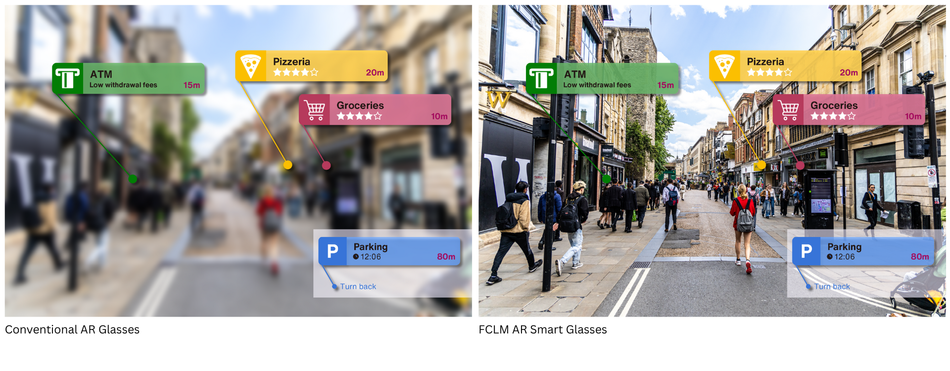Transforming Vision: The Fundamentals of Direct Retinal Projection in AR-VR
Explore how TDKs Direct Retinal Projection DRP technology offers a breakthrough, enabling compact, energy-efficient AR glasses designed for all-day wear.

Image Direct retinal projection by FCLM Full-Color Laser Modules. Source TDK
The fields of augmented and virtual reality (AR/VR) continue to make significant strides toward the promise of revolutionizing how people interact with digital information. However, despite advancements in computing power and optics, display technology has remained a major bottleneck, preventing AR/VR from achieving mass adoption. Existing headsets and smart glasses rely on bulky display systems that often introduce trade-offs in image quality, power efficiency, and comfort. Ultimately, such limitations have hindered the development of lightweight, all-day-wearable AR glasses.
To overcome these challenges, a breakthrough in display technology is needed: one that eliminates the constraints of conventional projection systems while enhancing power efficiency, resolution, and form factor. That’s why TDK is pioneering Direct Retinal Projection (DRP) technology.
Read on to learn about the ways that DRP is set to revolutionize AR/VR and how TDK is helping drive the field forward.
What is Direct Retinal Projection?
DRP is a novel imaging technique that fundamentally changes how digital visuals are delivered to the human eye. Where traditional displays generate images on a screen before projecting them into the user’s field of view, DRP bypasses the need for a physical display entirely. Instead, it projects laser light directly onto the retina to form a vivid, high-resolution image that remains sharp and stable regardless of eye focus.
By eliminating bulky optics and traditional display panels, DRP allows for ultra-compact and lightweight AR glasses that maintain high-quality imaging without the size and power constraints of conventional projection systems. This approach also removes the need for intermediary display surfaces so that the image appears sharp and clear regardless of the user's focal distance.
How DRP Works
Central to DRP technology is a full-color RGB laser module, such as TDK’s Full-Color Laser Module (FCLM). This ultra-miniaturized laser system generates precise beams of red, green, and blue light, which together form a full-color image. Where conventional systems struggle to cohesively blend individual laser sources, TDK’s advanced optical integration technology precisely couples red, green, and blue laser beams to form a single, unified full-color light source. The high-precision color mixing process guarantees that the projected image maintains perfect color uniformity and consistency.
The laser beams are then directed onto a MEMS (Micro-Electro-Mechanical System) scanning mirror, which rapidly sweeps the beam in a controlled pattern. This scanning process traces the image line by line across the retina to create a complete and stable projection that the user perceives as a natural visual element.
Since the image is formed directly on the retina, it remains in focus automatically, regardless of where the user is looking or how their eyes adjust to different focal depths. This focus-free nature of DRP provides a major advantage over traditional AR/VR displays which require complex optics and focus adjustments to maintain a stable image. This focus-free property is one of the primary factors that makes DRP uniquely suited for next-generation AR/VR applications.
Major Benefits of DRP for AR/VR
Power Efficiency
One of the most significant advantages of DRP is its exceptional power efficiency. In many cases, conventional AR/VR projection systems, which rely on high-power microdisplays, backlighting, and optics-heavy waveguides, can consume hundreds of milliwatts of power to operate. DRP requires only a few microwatts to generate high-quality imagery, which is a four to five orders of magnitude reduction in power consumption.
The low power consumption of DRP translates into a longer battery life, which allows AR glasses to be worn for an entire day without the need for frequent recharging or bulky battery packs. Current AR/VR headsets struggle with battery constraints, often lasting only a few hours before requiring a charge. By eliminating unnecessary optical layers and directly projecting light onto the retina, DRP optimizes energy use and significantly extends device runtime.
Beyond battery life, the efficiency of DRP also minimizes heat generation. Traditional microdisplay-based systems generate considerable heat, often requiring additional cooling mechanisms that add complexity to the design. Excess heat in AR/VR devices contributes to user discomfort, particularly in prolonged use cases. DRP mitigates this issue by operating at an inherently lower power level, keeping the device cooler and more comfortable.
Compact and Lightweight Design
The difference in form factor between DRP-based AR glasses and traditional AR/VR headsets is substantial. Existing headsets require display panels and additional optical components, making them impractical for all-day use. Even the most advanced AR glasses available today still rely on semi-transparent waveguides that add weight and require external projection hardware.
DRP removes these limitations by delivering images directly to the retina for a drastic reduction in device size and weight. TDK’s DRP is powered by TDK’s ultra-miniaturized laser module, which measures just 10.8 x 5.5 x 2.7 mm and weighs only 0.35 grams. This tiny laser system, coupled with MEMS-based scanning technology, fits seamlessly inside the frame of standard glasses without adding noticeable bulk.
Flicker-Free Imaging
Conventional laser projection systems often struggle with flicker noise, a visual artifact caused by interference between multiple light paths. As light waves interact within waveguides or optical combiners, small phase differences can create instability in the image and lead to subtle but noticeable flickering. This effect becomes more pronounced in dynamic AR/VR environments where users move their heads frequently and alter the angle at which light enters their eyes.
DRP eliminates flicker noise entirely by bypassing intermediary optics and projecting light directly onto the retina. With no waveguides or reflective elements to create interference patterns, DRP guarantees that images remain stable regardless of environmental lighting conditions. The direct nature of this projection method results in a smoother, more consistent visual experience that is free from the artifacts commonly associated with traditional laser projection.
For users, flicker-free imaging translates into greater long-term viewing comfort, reduced eye strain, and less fatigue during extended AR/VR sessions. The stability of DRP-based visuals also improves depth perception and spatial awareness, as digital overlays remain clear and precisely positioned in real-world environments. All things considered, eliminating flicker noise allows DRP to deliver a more immersive and natural viewing experience.
Scalability – Higher Resolution Without Size Increase
With traditional display technologies, increasing pixel density to achieve higher resolutions inevitably requires larger panels or denser microdisplays. This design limitation makes it difficult to balance high resolution, compact size, and power efficiency in AR/VR systems. As resolution increases, microdisplays need more energy to drive additional pixels, further confounding thermal management and battery life.
DRP takes a fundamentally different approach by using a scanning laser system instead of a pixel-based display. Resolution is determined not by physical screen size but by laser scanning speed. By increasing the speed at which the laser sweeps across the retina, DRP can enhance resolution without altering the size of the projection hardware. This method allows for ultra-high-resolution displays in a compact form factor, making it possible to achieve 4K or even higher resolutions without increasing the size or power demands of the device.
This scalability is extremely important for AR glasses, as maintaining a lightweight, unobtrusive design is essential for adoption. With DRP, compact AR eyewear can deliver high-definition, immersive visuals without the need for bulky optics or larger projection systems.
TDK is Advancing DRP Technology
The success of DRP hinges directly on our ability to miniaturize and optimize optical components. TDK has been instrumental in developing the ultra-compact laser and scanning systems that make DRP viable for lightweight, wearable AR glasses. Through its expertise in precision optical engineering and advanced manufacturing, TDK has overcome major barriers in size, alignment accuracy, and color fidelity, enabling a new generation of AR/VR displays.
Miniaturization of DRP Components
A primary challenge in implementing DRP technology is reducing the size of projection components while maintaining high optical performance. TDK has pioneered the development of ultra-miniaturized full-color laser modules, which serve as the light source for DRP systems. These modules integrate into compact AR eyewear and allow DRP to be implemented in sleek, everyday glasses rather than bulky headsets.
An innovation in this miniaturization effort is the integration of Photonic Integrated Circuit (PIC) technology. Whereas conventional optical projection systems require lenses and mirrors to manipulate light, TDK’s PLC approach enables a lens-free, ultra-thin optical system that guides laser beams with high precision and minimal energy loss. This integration eliminates complex optical paths and reduces both size and power consumption while maintaining high image quality and efficiency.
Laser Integration Technology
For DRP to deliver a clear and stable image, precise laser alignment is needed. TDK has developed Laser Integration Technology, which ensures sub-micron precision in laser placement. This technology guarantees that laser beams enter the scanning system with optimal accuracy and prevents distortions or misalignments that could degrade image quality.
For sophisticated laser integration, it’s necessary to carefully handle multiple back-end processes. Naturally, active alignment between the laser and PIC is the key to minimizing the optical loss and, once the optimum position is found, the components need to be bonded strongly enough. TDK solves this challenge with an internally developed assembly machine capable of mass production.
Although this process is key, the solution’s performance is also highly dependent on the pre-process before the active alignment bonding. In the pre-process, each component needs to be precisely polished to make a flat surface in order for the active alignment process to be stable and precise. TDK has a well-established mechanical fine-polishing process that results in high-quality laser integration.
Additionally, conventional projection methods often rely on complex mechanical calibrations and suffer from alignment inefficiencies. TDK’s Active Alignment approach automates and optimizes the positioning process at the nanometer level. Such a breakthrough significantly improves production scalability and reliability and makes DRP a practical solution for mass-market AR/VR applications.
TDK’s Full-Color Laser Module (FCLM)
TDK’s Full-Color Laser Module (FCLM) is a highly efficient, miniaturized light engine capable of producing 16.2 million colors for vivid, high-resolution image reproduction. The solution uses precision laser control to generate sharp, vibrant images with minimal power consumption.
Beyond color accuracy, FCLM is also designed for industry-leading power efficiency, consuming only a fraction of the energy required by traditional projection systems. Combined with TDK’s expertise in miniaturization and optical precision, the FCLM unlocks unprecedented performance for wearable AR/VR display technologies.
Conclusion
Direct Retinal Projection can completely change how AR/VR displays are designed and experienced. By eliminating the need for traditional screens, bulky optics, and waveguides, DRP overcomes some major limitations that have hindered the development of lightweight, high-performance AR glasses.
TDK is a pioneer in DRP technology, having developed ultra-miniaturized laser modules, precision alignment techniques, and efficient projection systems that make this technology viable today. As DRP continues to evolve, it will shape the future of immersive computing and wearable displays to bring us closer to a world where AR glasses truly integrate into everyday life.
To learn more, get in touch with TDK here.

